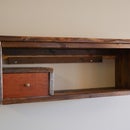Introduction: Modern Side Table
This modern side table was designed to be a quick project that you can build over a couple of weekends. I painted it using the Snow White milk paint from General finishes and the contrasting walnut drawer fronts really stand out.
The table is 15 3/4" wide, 48" long and is 31" tall. To build it you only need a table saw, jig saw, trim router and a drill. For the joinery, I am using the Kreg pocket hole jig and screws to help make this a quick project that anyone with a set of basic tools can build.
Thanks for checking this project out. Be sure to subscribe to my YouTube channel for more build videos. For more details about this project check out the article on my site. Enjoy!
Step 1: Tools & Materials Used
I was able to get all parts out of one full 3/4" sheet and for the back panel I had a scrap piece of 1/4" plywood that I used. For the walnut drawer fronts, you will need a piece that is approximately 7" wide by 48" long and is 3/4" thick.
Products used in build:
- Kreg Pocket Hole Jig
- Kreg 1 1/4" Screws
- Drill
- 1/2" Flush Trim Bit
- Pipe Clamps
- Quick Clamps
- Stain Blocker White Primer
- Snow White Milk Paint
- Semi-Gloss High Performance Top Coat
- Semi-Gloss Arm-R-Seal Varnish
- Foam Roller
- Foam Roller Inserts
- 14" Soft-Close Drawer Slides
Step 2: Cut the Plywood Pieces for the Case
I begin by cutting the sides and top panel to width at the table saw since they are all the same width of 15 3/4". Next I change the fence setting to 15" for the middle panel and cut it to width. To cut the bottom shelf I reset the fence one last time to 10" and cut it to width.
Step 3: Cutting Parts to Length
After cutting the panels to width I needed to cut them to length using my crosscut sled at the table saw. I began by truing up one end of the panels and then using a stop block, I cut them to their final length. The top, middle and bottom panels were all cut to 46 1/2" in length and the legs were cut to 31".
Moving on to the drawers, I first cut all of the side pieces to 5 1/2" in width and then using the stop block at the crosscut sled, cut them to length.
I first set the stop block to 12 1/2" for the shorter drawer sides and then reset it to 14 3/4" for the longer drawer sides.
Step 4: Lets Cut the Design Element in the Side Panels
Before assembling the table I cut out the design elements on the legs by first striking a line 3" from the sides and then connecting the two marks with the combination square set to 1 1/2".
Since I'm using a jigsaw to remove the waste I drilled 2 pilot holes for the saw blade to fit in for the tight turns at the corner. Before drilling, I clamped a scrap board under the leg to prevent any tear out. Then I remove the waste using the jigsaw, staying 1/8" away from my line.
Step 5: Clean Up Jigsaw Cuts With a Trim Router and a Flush Trim Bit
The jigsaw left a pretty rough cut, so to clean it up, I used a 1/2" flush trim bit in my trim router. I taped some scrap plywood on my lines that I drew earlier and referenced the edges when removing the waste with the router.
Step 6: Fill Voids and Finish Sand the Surface
I used shop grade maple plywood for this project which means I had voids and knots to deal with. Before painting the table I filled them in with wood putty and let it dry.
Before assembling the table I sanded all of the panels with 180 and 220 grit sandpaper. This not only got the surface ready for paint, but it also removed the wood filler that I applied earlier.
Step 7: Drill Pocket Hole Joinery for the Legs
Next I put 4 pocket hole screws on each end of the top, middle and bottom panel to attach to the legs. To help hold the legs vertically, I placed the pieces in pipe clamps and clamped them in place. I also used a couple of quick clamps to make sure the top of the legs and the top panel were flush.
Step 8: Add Drawer Dividers
Next I drill the holes in the drawer dividers. One side gets 2 pocket holes and the other side of the divider gets 1 centered. To mark the placement of the dividers I make a mark 15" from the inside edge of the leg. I used a combination square to ensure the drawer dividers were square to the edge of the middle panel and clamped it in place before screwing it in place.
Step 9: Fill Screw Holes With Wood Filler
Even though you won't see the pocket holes, I wanted to hide them before painting. To fill the holes I used wood filler.
Step 10: Attaching Middle Panel
Next I attached the middle panel to the drawer dividers using 2 screws in each divider and then 4 pocket holes on each end of the panel.
Step 11: Attaching Bottom Shelf
I drill 3 pocket holes on the underside of each end of the bottom shelf. To make the installation of the bottom shelf a little easier, I clamped a couple of spacers to the legs that the bottom shelf will sit on while installing the screws. After placing the shelf in place, I used a combination square set to 2 7/8" to set the spacing from the front edge of the table. Next I used pipe clamps to secure the legs to the bottom shelf while I install the pocket screws.
Step 12: Cutting Drawer Sides to Size & Route Groove for Bottom Panel
Back over at the table saw I cut the drawer sides to 5 1/2" wide and then to length using a stop block at the crosscut sled. The shorter drawer sides are 12 1/2" long and the longer drawer sides are 14 3/4".
Over at the router table I route a 1/4" groove 1/4" deep for the drawer bottoms using a 1/4" spiral bit.
Step 13: Cut Drawer Bottoms & Assemble the Drawers
I cut the 1/4" drawer bottoms to size at the table saw by first cutting them to 13" wide and then to 13 3/4" long.
Each drawer front gets 4 pocket holes (2 on each end) to attach to the drawer sides. To assemble the drawers I first put the bottom panel in the side panels and then the front/back panels. I placed the box in clamps to hold it while installing the screws.
Step 14: Installing Drawer Slides
To install the drawer slides I set my combination square to 2 1/4" and used it as a reference for locating and installing the drawer sides. I install the 3 screws per side.
With the drawer slides re-installed, I used an 1/8" shim under my combination square to measure for a template that I can use for repeat-ability. The measurement of the combination square is the width of the template. The template is 1/16" inset from the edge and the drawer slide sits on top of the template while I install the 3 screws.
Step 15: Cutting Walnut Drawer Fronts to Size
Next I cut the 3/4" walnut drawer fronts to 6 3/4" wide. I cut each drawer front to size only after measuring the exact size referencing the opening on the table.
Step 16: Attaching Drawer Fronts
I pre-drilled 1/8" holes for the screws to attach the drawer fronts. To get the correct placement of the drawer fronts I first put some double sided tape on the drawer boxes to temporarily attach the drawer fronts.
Using 1/16" shims I align the drawer front and once everything looked good, made sure to put a good amount of pressure to make sure the drawer front is held in place by the tape. I slowly open the drawer and install the screws.
Step 17: Routing Cove for Drawer Handle (Optional)
Instead of using hardware for the pulls, I put a cove on the inside bottom edge of the drawer fronts that I can use to open the drawers.
Step 18: Cut 1/4" Back Panel to Size
The final piece to cut was the back. I begin by cutting it to 6" wide and then to 46 1/2" long.
Step 19: Painting and Varnishing the Table
General Finishes was kind enough to send me a few products to use on this table. The stain blocker white primer, Snow White milk paint and the High Performance Semi-Gloss top coat. For the walnut I'm using a Semi-Gloss Arm-R-Seal wiping varnish.
I begin the finishing process by first applying two coats of primer using a foam roller. After the first coat of primer I sand with 320 grit sandpaper and then apply a second coat. To remove the dust from sanding in between coats, I used a damp paper towel (water).
After the second coat of primer I apply the first coat of snow white milk paint, again, using a foam roller. After the first coat of paint I sand with 320 grit sandpaper and then apply the second and final coat of paint. To remove the dust from sanding in between coats, I used a damp paper towel (water).
To protect the paint and to give it a little sheen, I applied two coats of this semi-gloss high performance top coat. I applied it with a foam roller. After the first coat of high performance I sanded the surface with 320 grit sandpaper and applied a second coat. To remove the dust from sanding in between coats, I used a damp paper towel (water).
Step 20: Varnishing Drawer Fronts
Since I'm using walnut for the drawer fronts I wanted to use an oil base finish to pop the grain. I applied 3 coats of a semi-gloss Arm-R-Seal with a cotton cloth. After each coat of the varnish I sanded the surface with 320 grit sandpaper. To remove the dust from sanding, I used a tack cloth.
Step 21: Final Thoughts
I'm really excited with the outcome of this project. It was a fun build that I was able to knock out over a couple of weekends using nothing more than a saw, clamps and a drill. It has a nice modern look and the walnut really stands out with the darker, contrasting colors. Thanks for checking it out! Don't forget to stop by my YouTube channel and check out what else i'm working on.











